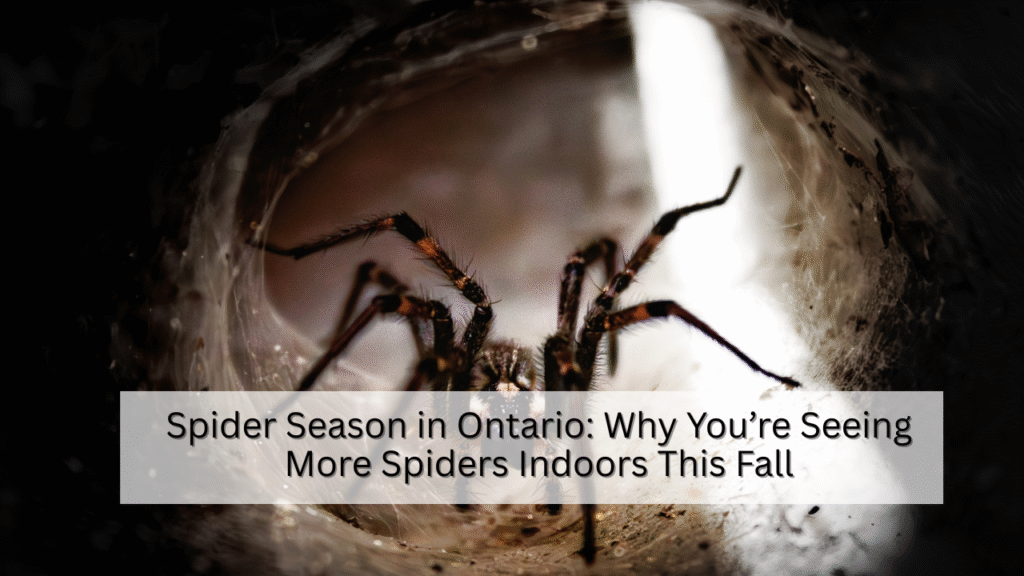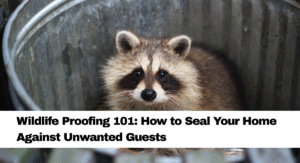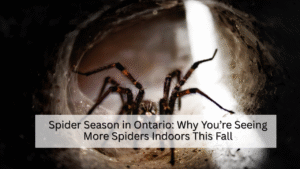You turn on the light, and there it is — a spider hanging quietly in the corner of your ceiling.
Your first thought? “Where did that come from?”
And your second: “If there’s one, there must be more.”
If you’ve noticed more spiders crawling around your home lately, you’re not imagining it.
Every fall, spider sightings spike across Ontario — from cozy suburban homes to city apartments. The reason has less to do with invasion and more to do with nature’s calendar.
Let’s unpack why this happens, which spiders you’re seeing, and how to keep them outside where they belong — without turning your home into a war zone.

Why Spiders Come Indoors in the Fall
Here’s the simple truth: spiders aren’t moving in because it’s cold. Most house spiders are born indoors and live their entire lives inside.
But fall is mating season — and that’s when they start wandering.
Male spiders, in particular, leave their webs to look for females. That’s why you suddenly start spotting them on walls, floors, or bathrooms around September and October.
So, when you see a spider strolling across the living room carpet, it’s not trying to move in. It’s looking for love.
Common Spiders Found in Ontario Homes
Ontario is home to dozens of spider species, but only a few are regular house guests.
Here are the ones you’re most likely to encounter — and what you should know about them.
1. Common House Spider
- Appearance: Small, brownish, with long legs and a round body.
- Where they hide: Corners, basements, closets, or behind furniture.
- Are they dangerous? Not at all. They prefer to avoid humans and spend their days catching small insects like flies or mosquitoes.
They’re actually helpful — but that doesn’t mean you want a collection of them in every corner.
2. Cellar Spider (a.k.a. Daddy Long Legs)
- Appearance: Long, thin legs with a tiny body.
- Where they hide: Basements, ceilings, garages, and laundry rooms.
- Are they dangerous? No. The myth that they’re deadly but can’t bite humans isn’t true — they’re harmless.
These spiders often take over dark corners and shake their webs when disturbed. It looks creepy, but it’s just defence behaviour.
3. Wolf Spider
- Appearance: Large, fast, and hairy — brown or gray with striped legs.
- Where they hide: Ground level — basements, garages, or near door gaps.
- Are they dangerous? No, but they look intimidating. They don’t build webs; they hunt.
Wolf spiders wander indoors during cooler weather. They move quickly but rarely bite, and if they do, it’s mild — like a mosquito bite.
4. Cobweb Spider
- Appearance: Small, round abdomen, messy web.
- Where they hide: Corners of rooms, windows, attics.
- Are they dangerous? No. They create the classic “spider web” look.
These spiders help control flies and moths, but their untidy webs make homes look neglected — one of the main reasons people call pest control.
5. Yellow Sac Spider
- Appearance: Pale yellow or greenish, small, smooth body.
- Where they hide: Curtains, wall corners, under furniture.
- Are they dangerous? Slightly. Their bite can cause mild redness or swelling, but they’re not aggressive.
They’re active at night and are one of the few spiders that sometimes bite humans, usually by accident when trapped in clothing or bedding.

Do Ontario Spiders Bite?
Most house spiders don’t bite — and if they do, it’s rare and harmless.
Out of all species found in Ontario, none are medically dangerous. There are no native black widows or brown recluses hiding in basements here (despite internet myths).
That said, spider bites can cause mild irritation or swelling, similar to a mosquito bite. If it gets worse or infected, a doctor can easily treat it.
Why Spiders Choose Your Home
Here’s what attracts them:
- Insects: Spiders go where the food is. If you have fruit flies, gnats, or moths, spiders move in to hunt.
- Warmth: As fall sets in, your home stays cozy and inviting.
- Moisture: Bathrooms, basements, and laundry rooms draw both spiders and the insects they eat.
- Clutter: Stacks of boxes, clothes, or papers make perfect hiding spots.
You’re not inviting them on purpose — your home just provides everything they need to thrive.
How to Keep Spiders Away Naturally
You don’t need harsh chemicals to reclaim your space. A few consistent habits go a long way.
1. Declutter Regularly
Spiders love undisturbed spaces. Clean out corners, storage boxes, and under beds.
Even moving furniture occasionally helps break their hiding spots.
2. Vacuum Webs and Egg Sacs
If you see webs, don’t just brush them away — vacuum them. This removes the web, eggs, and any hidden spiders.
3. Seal Entry Points
Use caulk around windows, doors, and vents. Check for small gaps in your basement or attic where other insects (their prey) might enter.
4. Turn Off Outdoor Lights
Outdoor lighting attracts flying insects, which attract spiders. Use yellow “bug bulbs” instead — they’re less appealing to both.
5. Use Natural Repellents
Spiders dislike strong scents like peppermint, eucalyptus, and citrus.
Mix a few drops of essential oil with water and spray around windows and corners.
6. Reduce Moisture
Use a dehumidifier in basements and fix leaky pipes. Dry spaces mean fewer bugs — and fewer spiders following them.
When DIY Isn’t Enough
If you’re constantly finding new webs, no matter how much you clean, there’s likely an underlying insect problem attracting them.
In that case, you’re treating the symptom, not the cause.
Professional pest control companies like BugManagers can identify the food source, locate nests, and use safe, precise treatments to stop both spiders and the insects they’re feeding on.
You don’t need harsh chemicals or foggers — just a focused approach that targets the problem where it starts.
What a Professional Spider Control Service Includes
At BugManagers, spider control is part of a complete pest management plan.
Here’s what we do:
1. Inspection
We inspect the entire property — walls, basements, attics, and exterior areas — to identify spider species and entry points.
2. Cleaning and Removal
We remove visible webs, egg sacs, and debris that attract insects.
3. Targeted Treatment
We apply safe, low-impact treatments around problem areas — focusing on cracks, windows, and moisture zones where spiders hide.
4. Prevention Planning
We help you seal entry points, adjust lighting, and control other insects so spiders have no reason to return.
The goal isn’t to kill every spider on your property — it’s to restore balance. Spiders outside are beneficial; inside, they’re pests. We help you keep that boundary clear.
Why Fall Is the Perfect Time for Spider Control
Autumn is when spider activity peaks, but it’s also when prevention works best.
By treating in the fall, you:
- Stop spiders before they lay eggs for winter.
- Prevent egg sacs from hatching indoors during the cold months.
- Reduce other pests that attract spiders later.
Think of it like a seasonal reset — clearing out what’s built up before it becomes a bigger issue.
Final Thoughts
Seeing spiders inside your home doesn’t mean it’s infested — it means nature is doing what it does every fall.
Still, that doesn’t mean you have to live with webs in every corner.
A few smart changes, regular cleaning, and good sealing habits can make your home far less appealing to spiders.
And if you’re tired of sharing your space, BugManagers can step in to help — safely, quickly, and effectively.
So next time you see a spider in the corner, don’t panic. Just take it as a sign: it’s spider season — and time for a little fall pest checkup.







